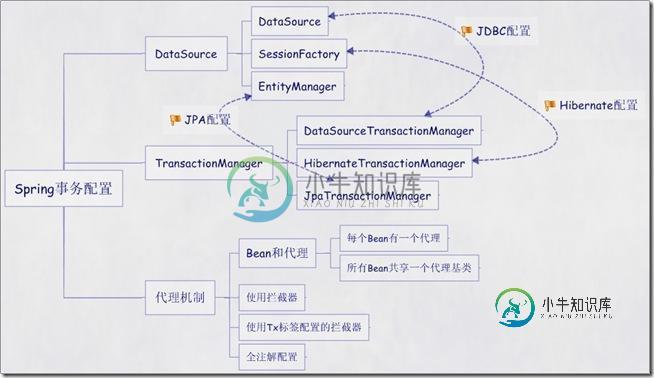Spring事务Transaction配置的五种注入方式详解
前段时间对spring的事务配置做了比较深入的研究,在此之间对Spring的事务配置虽说也配置过,但是一直没有一个清楚的认识。通过这次的学习发觉Spring的事务配置只要把思路理清,还是比较好掌握的。
总结如下:
Spring配置文件中关于事务配置总是由三个组成部分,分别是DataSource、TransactionManager和代理机制这三部分,无论哪种配置方式,一般变化的只是代理机制这部分。
DataSource、TransactionManager这两部分只是会根据数据访问方式有所变化,比如使用hibernate进行数据访问时,DataSource实际为SessionFactory,TransactionManager的实现为HibernateTransactionManager。
具体如下图:

根据代理机制的不同,总结了五种Spring事务的配置方式,配置文件如下:
第一种方式:每个Bean都有一个代理
<?xml version="1.0"encoding="UTF-8"?> <beans xmlns="http://www.springframework.org/schema/beans" xmlns:xsi="http://www.w3.org/2001/XMLSchema-instance" xmlns:context="http://www.springframework.org/schema/context" xmlns:aop="http://www.springframework.org/schema/aop" xsi:schemaLocation="http://www.springframework.org/schema/beans http://www.springframework.org/schema/beans/spring-beans-2.5.xsd http://www.springframework.org/schema/context http://www.springframework.org/schema/context/spring-context-2.5.xsd http://www.springframework.org/schema/aop http://www.springframework.org/schema/aop/spring-aop-2.5.xsd"> <bean id="sessionFactory" class="org.springframework.orm.hibernate3.LocalSessionFactoryBean"> <property name="configLocation" value="classpath:hibernate.cfg.xml" /> <property name="configurationClass" value="org.hibernate.cfg.AnnotationConfiguration" /> </bean> <!-- 定义事务管理器(声明式的事务) --> <bean id="transactionManager" class="org.springframework.orm.hibernate3.HibernateTransactionManager"> <property name="sessionFactory" ref="sessionFactory" /> </bean> <!-- 配置DAO --> <bean id="userDaoTarget" class="com.bluesky.spring.dao.UserDaoImpl"> <property name="sessionFactory" ref="sessionFactory" /> </bean> <bean id="userDao" class="org.springframework.transaction.interceptor.TransactionProxyFactoryBean"> <!-- 配置事务管理器 --> <property name="transactionManager" ref="transactionManager" /> <property name="target" ref="userDaoTarget" /> <property name="proxyInterfaces" value="com.bluesky.spring.dao.GeneratorDao" /> <!-- 配置事务属性 --> <property name="transactionAttributes"> <props> <prop key="*"> PROPAGATION_REQUIRED </prop> </props> </property> </bean> </beans>
第二种方式:所有Bean共享一个代理基类
<?xml version="1.0"encoding="UTF-8"?> <beans xmlns="http://www.springframework.org/schema/beans" xmlns:xsi="http://www.w3.org/2001/XMLSchema-instance" xmlns:context="http://www.springframework.org/schema/context" xmlns:aop="http://www.springframework.org/schema/aop" xsi:schemaLocation="http://www.springframework.org/schema/beans http://www.springframework.org/schema/beans/spring-beans-2.5.xsd http://www.springframework.org/schema/context http://www.springframework.org/schema/context/spring-context-2.5.xsd http://www.springframework.org/schema/aop http://www.springframework.org/schema/aop/spring-aop-2.5.xsd"> <bean id="sessionFactory" class="org.springframework.orm.hibernate3.LocalSessionFactoryBean"> <property name="configLocation" value="classpath:hibernate.cfg.xml" /> <property name="configurationClass" value="org.hibernate.cfg.AnnotationConfiguration" /> </bean> <!-- 定义事务管理器(声明式的事务) --> <bean id="transactionManager" class="org.springframework.orm.hibernate3.HibernateTransactionManager"> <property name="sessionFactory" ref="sessionFactory" /> </bean> <bean id="transactionBase" class="org.springframework.transaction.interceptor.TransactionProxyFactoryBean" lazy-init="true" abstract="true"> <!-- 配置事务管理器 --> <property name="transactionManager" ref="transactionManager" /> <!-- 配置事务属性 --> <property name="transactionAttributes"> <props> <prop key="*">PROPAGATION_REQUIRED </prop> </props> </property> </bean> <!-- 配置DAO --> <bean id="userDaoTarget" class="com.bluesky.spring.dao.UserDaoImpl"> <property name="sessionFactory" ref="sessionFactory" /> </bean> <bean id="userDao" parent="transactionBase"> <property name="target" ref="userDaoTarget" /> </bean> </beans>
第三种方式:使用拦截器
<?xml version="1.0"encoding="UTF-8"?> <beans xmlns="http://www.springframework.org/schema/beans" xmlns:xsi="http://www.w3.org/2001/XMLSchema-instance" xmlns:context="http://www.springframework.org/schema/context" xmlns:aop="http://www.springframework.org/schema/aop" xsi:schemaLocation="http://www.springframework.org/schema/beans http://www.springframework.org/schema/beans/spring-beans-2.5.xsd http://www.springframework.org/schema/context http://www.springframework.org/schema/context/spring-context-2.5.xsd http://www.springframework.org/schema/aop http://www.springframework.org/schema/aop/spring-aop-2.5.xsd"> <bean id="sessionFactory" class="org.springframework.orm.hibernate3.LocalSessionFactoryBean"> <property name="configLocation" value="classpath:hibernate.cfg.xml" /> <property name="configurationClass" value="org.hibernate.cfg.AnnotationConfiguration" /> </bean> <!-- 定义事务管理器(声明式的事务) --> <bean id="transactionManager" class="org.springframework.orm.hibernate3.HibernateTransactionManager"> <property name="sessionFactory" ref="sessionFactory" /> </bean> <bean id="transactionInterceptor" class="org.springframework.transaction.interceptor.TransactionInterceptor"> <property name="transactionManager" ref="transactionManager" /> <!-- 配置事务属性 --> <property name="transactionAttributes"> <props> <prop key="*">PROPAGATION_REQUIRED </prop> </props> </property> </bean> <bean class="org.springframework.aop.framework.autoproxy.BeanNameAutoProxyCreator"> <property name="beanNames"> <list> <value> *Dao </value> </list> </property> <property name="interceptorNames"> <list> <value> transactionInterceptor </value> </list> </property> </bean> <!-- 配置DAO --> <bean id="userDao" class="com.bluesky.spring.dao.UserDaoImpl"> <property name="sessionFactory" ref="sessionFactory" /> </bean> </beans>
第四种方式:使用tx标签配置的拦截器
<?xml version="1.0"encoding="UTF-8"?> <beans xmlns="http://www.springframework.org/schema/beans" xmlns:xsi="http://www.w3.org/2001/XMLSchema-instance" xmlns:context="http://www.springframework.org/schema/context" xmlns:aop="http://www.springframework.org/schema/aop" xmlns:tx="http://www.springframework.org/schema/tx" xsi:schemaLocation="http://www.springframework.org/schema/beans http://www.springframework.org/schema/beans/spring-beans-2.5.xsd http://www.springframework.org/schema/context http://www.springframework.org/schema/context/spring-context-2.5.xsd http://www.springframework.org/schema/aop http://www.springframework.org/schema/aop/spring-aop-2.5.xsd http://www.springframework.org/schema/tx http://www.springframework.org/schema/tx/spring-tx-2.5.xsd"> <context:annotation-config /> <context:component-scan base-package="com.bluesky" /> <bean id="sessionFactory" class="org.springframework.orm.hibernate3.LocalSessionFactoryBean"> <property name="configLocation" value="classpath:hibernate.cfg.xml" /> <property name="configurationClass" value="org.hibernate.cfg.AnnotationConfiguration" /> </bean> <!-- 定义事务管理器(声明式的事务) --> <bean id="transactionManager" class="org.springframework.orm.hibernate3.HibernateTransactionManager"> <property name="sessionFactory" ref="sessionFactory" /> </bean> <tx:advice id="txAdvice" transaction-manager="transactionManager"> <tx:attributes> <tx:method name="*" propagation="REQUIRED" /> </tx:attributes> </tx:advice> <aop:config> <aop:pointcut id="interceptorPointCuts" expression="execution(*com.bluesky.spring.dao.*.*(..))" /> <aop:advisor advice-ref="txAdvice" pointcut-ref="interceptorPointCuts" /> </aop:config> </beans>
第五种方式:全注解
<?xml version="1.0" encoding="UTF-8"?> <beans xmlns="http://www.springframework.org/schema/beans" xmlns:xsi="http://www.w3.org/2001/XMLSchema-instance" xmlns:context="http://www.springframework.org/schema/context" xmlns:aop="http://www.springframework.org/schema/aop" xmlns:tx="http://www.springframework.org/schema/tx" xsi:schemaLocation="http://www.springframework.org/schema/beans http://www.springframework.org/schema/beans/spring-beans-2.5.xsd http://www.springframework.org/schema/context http://www.springframework.org/schema/context/spring-context-2.5.xsd http://www.springframework.org/schema/aop http://www.springframework.org/schema/aop/spring-aop-2.5.xsd http://www.springframework.org/schema/tx http://www.springframework.org/schema/tx/spring-tx-2.5.xsd"> <context:annotation-config /> <context:component-scan base-package="com.bluesky" /> <tx:annotation-driven transaction-manager="transactionManager"/> <bean id="sessionFactory" class="org.springframework.orm.hibernate3.LocalSessionFactoryBean"> <property name="configLocation" value="classpath:hibernate.cfg.xml" /> <property name="configurationClass" value="org.hibernate.cfg.AnnotationConfiguration" /> </bean> <!-- 定义事务管理器(声明式的事务) --> <bean id="transactionManager" class="org.springframework.orm.hibernate3.HibernateTransactionManager"> <property name="sessionFactory" ref="sessionFactory" /> </bean> </beans>
此时在DAO上需加上@Transactional注解,如下:
package com.bluesky.spring.dao;
import java.util.List;
import org.hibernate.SessionFactory;
import org.springframework.beans.factory.annotation.Autowired;
import org.springframework.orm.hibernate3.support.HibernateDaoSupport;
import org.springframework.stereotype.Component;
import com.bluesky.spring.domain.User;
@Transactional
@Component("userDao")
public class UserDaoImpl extends HibernateDaoSupport implements UserDao {
public List<User> listUsers() {
return this.getSession().createQuery("from User").list();
}
}
以上就是本文的全部内容,希望对大家的学习有所帮助,也希望大家多多支持小牛知识库。
-
本文向大家介绍详解Spring配置事务的五种方式,包括了详解Spring配置事务的五种方式的使用技巧和注意事项,需要的朋友参考一下 Spring配置文件中关于事务配置总是由三个组成部分,分别是 DataSource 、TransactionManager 和 代理机制 这三部分,无论哪种配置方式,一般变化的只是代理机制这部分。 DataSource、TransactionManager这两部分只
-
本文向大家介绍详解spring 配置的两种方式:JAVA配置和注解配置,包括了详解spring 配置的两种方式:JAVA配置和注解配置的使用技巧和注意事项,需要的朋友参考一下 众所周知,spring自从3.0开始以后,就全面推荐使用配置的方式进行代码编写了,这种方式确实可以避免了之前一个项目里面一大堆XML的情况,毕竟XML的可读性实在不怎么样,而且一会写JAVA,一会写XML,确实还是蛮麻烦的
-
本文向大家介绍Spring Bean三种注入方式详解,包括了Spring Bean三种注入方式详解的使用技巧和注意事项,需要的朋友参考一下 在Spring容器中为一个bean配置依赖注入有三种方式: 使用属性的setter方法注入 这是最常用的方式; 使用构造器注入; 使用Filed注入(用于注解方式). Field注入是最常见的一种方式,可以采用 @Autowired 对Bean类的接口
-
本文向大家介绍详解Spring中bean的几种注入方式,包括了详解Spring中bean的几种注入方式的使用技巧和注意事项,需要的朋友参考一下 首先,要学习Spring中的Bean的注入方式,就要先了解什么是依赖注入。依赖注入是指:让调用类对某一接口的实现类的实现类的依赖关系由第三方注入,以此来消除调用类对某一接口实现类的依赖。 Spring容器中支持的依赖注入方式主要有属性注入、构造函数注入、工
-
主要内容:事务管理方式,事务管理器,TransactionStatus 接口事务(Transaction)是基于关系型数据库(RDBMS)的企业应用的重要组成部分。在软件开发领域,事务扮演者十分重要的角色,用来确保应用程序数据的完整性和一致性。 事务具有 4 个特性:原子性、一致性、隔离性和持久性,简称为 ACID 特性。 原子性(Atomicity):一个事务是一个不可分割的工作单位,事务中包括的动作要么都做要么都不做。 一致性(Consistency):事务必须保证数
-
本文向大家介绍Spring 使用注解方式进行事务管理配置方式,包括了Spring 使用注解方式进行事务管理配置方式的使用技巧和注意事项,需要的朋友参考一下 使用步骤: 步骤一、在spring配置文件中引入<tx:>命名空间 步骤二、具有@Transactional 注解的bean自动配置为声明式事务支持 步骤三、在接口或类的声明处 ,写一个@Transactional. 要是只在接口上写, 接口的

